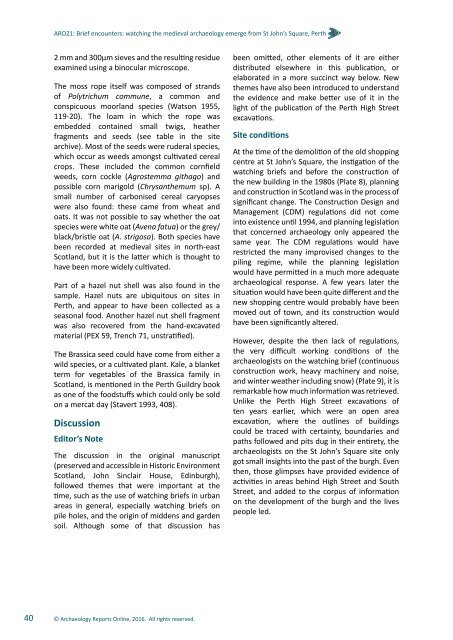medieval archaeology emerge from St John’s Square Perth
ARO21_St_Johns_Square
ARO21_St_Johns_Square
Create successful ePaper yourself
Turn your PDF publications into a flip-book with our unique Google optimized e-Paper software.
ARO21: Brief encounters: watching the <strong>medieval</strong> <strong>archaeology</strong> <strong>emerge</strong> <strong>from</strong> <strong>St</strong> <strong>John’s</strong> <strong>Square</strong>, <strong>Perth</strong><br />
2 mm and 300μm sieves and the resulting residue<br />
examined using a binocular microscope.<br />
The moss rope itself was composed of strands<br />
of Polytrichum commune, a common and<br />
conspicuous moorland species (Watson 1955,<br />
119-20). The loam in which the rope was<br />
embedded contained small twigs, heather<br />
fragments and seeds (see table in the site<br />
archive). Most of the seeds were ruderal species,<br />
which occur as weeds amongst cultivated cereal<br />
crops. These included the common cornfield<br />
weeds, corn cockle (Agrostemma githago) and<br />
possible corn marigold (Chrysanthemum sp). A<br />
small number of carbonised cereal caryopses<br />
were also found: these came <strong>from</strong> wheat and<br />
oats. It was not possible to say whether the oat<br />
species were white oat (Avena fatua) or the grey/<br />
black/bristle oat (A. strigosa). Both species have<br />
been recorded at <strong>medieval</strong> sites in north-east<br />
Scotland, but it is the latter which is thought to<br />
have been more widely cultivated.<br />
Part of a hazel nut shell was also found in the<br />
sample. Hazel nuts are ubiquitous on sites in<br />
<strong>Perth</strong>, and appear to have been collected as a<br />
seasonal food. Another hazel nut shell fragment<br />
was also recovered <strong>from</strong> the hand-excavated<br />
material (PEX 59, Trench 71, unstratified).<br />
The Brassica seed could have come <strong>from</strong> either a<br />
wild species, or a cultivated plant. Kale, a blanket<br />
term for vegetables of the Brassica family in<br />
Scotland, is mentioned in the <strong>Perth</strong> Guildry book<br />
as one of the foodstuffs which could only be sold<br />
on a mercat day (<strong>St</strong>avert 1993, 408).<br />
Discussion<br />
Editor’s Note<br />
The discussion in the original manuscript<br />
(preserved and accessible in Historic Environment<br />
Scotland, John Sinclair House, Edinburgh),<br />
followed themes that were important at the<br />
time, such as the use of watching briefs in urban<br />
areas in general, especially watching briefs on<br />
pile holes, and the origin of middens and garden<br />
soil. Although some of that discussion has<br />
been omitted, other elements of it are either<br />
distributed elsewhere in this publication, or<br />
elaborated in a more succinct way below. New<br />
themes have also been introduced to understand<br />
the evidence and make better use of it in the<br />
light of the publication of the <strong>Perth</strong> High <strong>St</strong>reet<br />
excavations.<br />
Site conditions<br />
At the time of the demolition of the old shopping<br />
centre at <strong>St</strong> <strong>John’s</strong> <strong>Square</strong>, the instigation of the<br />
watching briefs and before the construction of<br />
the new building in the 1980s (Plate 8), planning<br />
and construction in Scotland was in the process of<br />
significant change. The Construction Design and<br />
Management (CDM) regulations did not come<br />
into existence until 1994, and planning legislation<br />
that concerned <strong>archaeology</strong> only appeared the<br />
same year. The CDM regulations would have<br />
restricted the many improvised changes to the<br />
piling regime, while the planning legislation<br />
would have permitted in a much more adequate<br />
archaeological response. A few years later the<br />
situation would have been quite different and the<br />
new shopping centre would probably have been<br />
moved out of town, and its construction would<br />
have been significantly altered.<br />
However, despite the then lack of regulations,<br />
the very difficult working conditions of the<br />
archaeologists on the watching brief (continuous<br />
construction work, heavy machinery and noise,<br />
and winter weather including snow) (Plate 9), it is<br />
remarkable how much information was retrieved.<br />
Unlike the <strong>Perth</strong> High <strong>St</strong>reet excavations of<br />
ten years earlier, which were an open area<br />
excavation, where the outlines of buildings<br />
could be traced with certainty, boundaries and<br />
paths followed and pits dug in their entirety, the<br />
archaeologists on the <strong>St</strong> <strong>John’s</strong> <strong>Square</strong> site only<br />
got small insights into the past of the burgh. Even<br />
then, those glimpses have provided evidence of<br />
activities in areas behind High <strong>St</strong>reet and South<br />
<strong>St</strong>reet, and added to the corpus of information<br />
on the development of the burgh and the lives<br />
people led.<br />
40<br />
© Archaeology Reports Online, 2016. All rights reserved.


